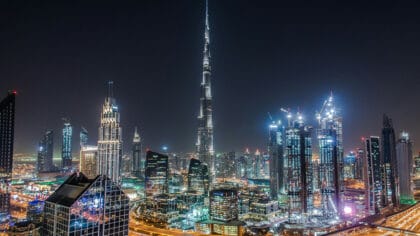Net Zero is the point where the amount of carbon we release into the atmosphere is equal to the amount we remove. It’s an important target to work towards to tackle climate change. And there’s all sorts of plans and people involved in this challenge.
Now, we all LOVE renewable energy, but whilst supplies are increasing, they aren’t currently sufficient to meet everyday demand. So that means we still are reliant, to a degree, on fossil fuels such as coal and gas.
For many years, the UK has used natural gas from underneath the North Sea, where it’s found deep under the earth in layers of rock that have many tiny holes – a bit like a sponge. But as it’s got harder – and more expensive to get these supplies, the UK now imports quite a lot of the gas we use from elsewhere.

But gas isn’t necessarily the easiest thing to transport. Just think about inflated balloons – very squidgy and not that easy to carry around, especially if you’ve got lots!
L-N-G stands for LIQUEFIED NATURAL GAS. It’s basically natural gas but in liquid form. L – N – G is formed by chilling natural gas to MINUS 161 degrees centigrade, at which temperature it occupies 600 times less space than in its gaseous form. This makes it much easier to store and transport large volumes from gas producing areas like Algeria, Trinidad and the Middle East.
It makes a lot of sense to use this form of gas. As a liquid, the gas takes up less space, it’s much easier to transport and also you get more gas on each ship – which means less fuel is used to ship it around which is good for the environment.
Bringing gas from other countries means we need to store it safely here when it arrives, and that’s where gas terminals like one on the Isle of Grain in Kent, come into the picture. It has 8 huge tanks to store L – N – G, with more being built. Some of these tanks are larger than the Royal Albert Hall in London.

As the ships that carry L – N – G are very VERY large – around 3 football pitches in length, they need enormous marine jetties to unload them using special metal arms that connect using valves so large you could climb inside them. As L – N – G is very cold, the pipes end up covered in frost after unloading.
The L – N – G is stored onshore before being sent to its final destinations. But before it’s sent out, it has to go through a process called ‘regassification’. That’s where it’s made back into a gas!
Sea water is usually used to heat it up. A strong smell is also added before it’s sent into the network to make it easier for people to detect any leaks!
Although there is a long journey to get to net zero, LNG can help us to bridge the gap between dirtier fuels such as coal, and renewables like wind and solar.

And with new types of fuel and facilities like the one on the Isle of Grain, there are new jobs being created for people to be part of this positive change.
Engineers who design and maintain the enormous tanks, crews on the ships carrying the fuel, and people who oversee the transport hub to ensure it’s delivered safely to where it’s needed.
Marina Ventura: Energy Explorer is made with support from Grid for Good by the National Grid







